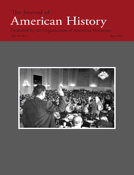-
Views
-
Cite
Cite
Beverly Gage, Terrorism and the American Experience: A State of the Field, Journal of American History, Volume 98, Issue 1, June 2011, Pages 73–94, https://doi.org/10.1093/jahist/jar106
Close - Share Icon Share
Extract
In 1970, just months before his death, the historian Richard Hofstadter called on U.S. historians to engage the subject of violence. For a generation, he wrote, the profession had ignored the issue, assuming that consensus rather than conflict had shaped the American past. By the late 1960s, with assassinations, riots, and violent crime at the forefront of national anxieties, that assumption was no longer tenable. Everywhere, Americans seemed to be thinking and talking about violence, except within the historical profession. Hofstadter urged historians to remedy their “inattention” and construct a history of violence that would speak to both the present and the past.1
Over the last four decades, the historical profession has responded to that challenge. Studies of racial conflict, territorial massacres, gendered violence, empire, crime and punishment, and war and memory make up some of the most esteemed books of the past generation. Yet on the subject of “terrorism,” the form of violence that currently dominates American political discourse, historians have had comparatively little to say. Since the attacks of September 11, 2001, a handful of conferences have addressed historical aspects of terrorism, from its nineteenth-century origins to its impact on state building and national identity. Scholarly journals (including the Journal of American History) have devoted the occasional special issue to examining terrorism's roots and present-day implications. Within the historical profession, several book-length works have taken up episodes of terrorism, examining the production of both violence and state repression. Social scientists and journalists have offered sweeping global histories, tracing the problem of terrorism from antiquity to the present.2





